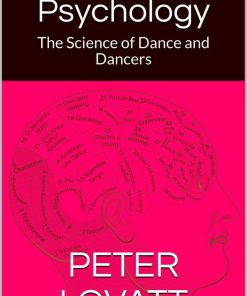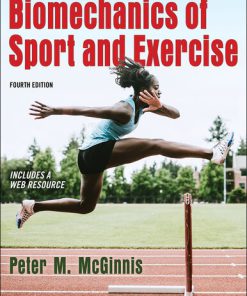The Psychology of Perfectionism in Sport Dance and Exercise 2nd Edition by Andrew P Hill ISBN 9781032263786 1032263784
$50.00 Original price was: $50.00.$25.00Current price is: $25.00.
The Psychology of Perfectionism in Sport Dance and Exercise 2nd Edition by Andrew P Hill – Ebook PDF Instant Download/Delivery: 9781032263786 ,1032263784
Full download The Psychology of Perfectionism in Sport Dance and Exercise 2nd Edition after payment

Product details:
ISBN 10: 1032263784
ISBN 13: 9781032263786
Author: Andrew P Hill
The Psychology of Perfectionism in Sport Dance and Exercise 2nd Edition Table of contents:
Part I: Conceptual, Measurement, and Development Issues
1. Conceptualizing Perfectionism: Resolving Old Quarrels and Starting New Ones
A Historical Overview of the Conceptualization of Perfectionism
Contemporary Multidimensional Models
Issues, Debates, and Controversies Revisited
Is the Tripartite Model Obsolete or Can it Be Re-envisaged?
Inclusion or Exclusion of Parental Pressure and Coach Pressure
Revisiting “Healthy Perfectionism” and its Alternatives in Sport, Dance, and Exercise
Concluding Comments
References
2. Advances in the Measurement of Perfectionism in Sport, Dance, and Exercise
Overview
The Two-Factor Model of Perfectionism
Proxies of Perfectionistic Strivings and Perfectionistic Concerns
(Sub-)Domain-Specificity of Perfectionism
General Measures
The Importance of Contextualization
Frost Multidimensional Perfectionism Scale (F-MPS)
Hewitt–Flett Multidimensional Perfectionism Scale (HF-MPS)
Domain-Specific Measures
Sport-Multidimensional Perfectionism Scale (S-MPS) and S-MPS-2
Multidimensional Inventory of Perfectionism in Sports (MIPS)
Sub-Domain-Specific Measures
Concluding Comments
References
3. Revisiting the Development of Perfectionism in Sport, Dance, and Exercise
Development of Perfectionism in Sport, Dance, and Exercise
A multi-pathway Model of Perfectionism Development
Pathway One: Social Learning Model
Extending the Social Learning Model: Parenting Styles and Practices
Pathway Two: Social Expectations Model
Pathway Three: Social Reaction Model
Pathway Four: Anxious Rearing Model
Recent Advances in Development Theory
Extending the Conceptual Model of Perfectionism Development for Sport, Dance, and Exercise
Completing the Conceptual Model of Perfectionism Development
Concluding Comments
References
Part II: Established Approaches and Models
4. An Update and Extension of the Independent Effects Approach to Perfectionism in Sport, Dance, and Exercise
Perfectionistic Strivings and Concerns in Sport, Dance, and Exercise
Perfectionism in Sport, Dance, and Exercise
Capturing the Independent Effects of Perfectionistic Strivings and Concerns
A Review of Research Examining Perfectionistic Strivings and Concerns
An Updated Review of the Independent Effects of Perfectionism
The Case for Total Unique Effects and Relative Weights
Concluding Comments
References
5. Re-envisioning the Tripartite Model of Perfectionism in Sport and Dance: An Updated Review and Response to Critiques
Foundations and History of the Tripartite Model
Evidence from Perfectionism Research in Sport and Dance
Studies that Utilized Person-Oriented Approaches to Analysis
Studies that Utilized Canonical Correlation Analysis
Studies that Utilized Qualitative Approaches to Analysis
Summary of Findings across Analytical Approaches
Responses to Critiques of the Tripartite Model
(Un)healthy Perfectionism Labels
Dimensional vs. Categorical Perfectionism
Pure Evaluative Concerns Perfectionism
Summary
Concluding Comments
References
6. The 2 × 2 Model of Perfectionism in Sport, Dance, and Exercise: An Updated and Critical Review
The 2 × 2 Model of Perfectionism
Key Definitions, Assumptions, and Hypotheses
Conceptual, Analytical, and Interpretational Considerations
Research in Sport, Dance, and Exercise
Reanalysing the Independent Effects of PSP and ECP with the 2 × 2 Model of Perfectionism
Direct Tests of the 2 × 2 Model of Perfectionism
Taking Stock and Moving Forward
Concluding Comments
References
Part III: New Approaches and Concepts
7. Perfectionistic Tipping Points and How to Find Them
Multidimensional Perfectionism
Illustrative Research Example
Step One – Moderated Regression Analyses
Step Two – Interpret the Results of the J-N Technique
Step Three – Plotting the Results of the J-N Technique
Future Directions and Questions
Concluding Comments
References
8. Perfectionism Cognitions in Sport, Dance, and Exercise
Comprehensive Model of Perfectionistic Behaviour
Perfectionism Cognitions Theory
Measuring Perfectionism Cognitions
Multidimensional versus Unidimensional Measurement
Research Examining Perfectionism Cognitions
Motivational Climates and Perfectionism Cognitions
Perfectionism Cognitions and Burnout
Perfectionism Cognitions and Emotions in Sport
Managing Perfectionism Cognitions in Sport
Other Future Directions for Research
Concluding Comments
References
9. Studying Perfectionistic Climates
Introducing and Conceptualizing Perfectionistic Climate
Applying Perfectionistic Climate to Sport
Initial Validity and Reliability Evidence for the PCQ-S
Expanding the Nomological Network of Perfectionistic Climate
Advancing Research on Perfectionistic Climate
Studying Perfectionistic Climate in Dance
Perfectionistic Climate as Group-Level Construct
Observed and Perceived Assessments of Perfectionistic Climate
Concluding Comments
References
Part IV: Applied Issues and Practitioner Perspectives
10. Working with Perfectionistic Athletes in Sport: An Acceptance and Commitment Therapy Perspective
Context for the Chapter
Cognitive Behavioural Therapy (CBT) and Acceptance and Commitment Therapy (ACT)
ACT and Managing Perfectionism
A Case Example of Perfectionism in High-Performance Sport
Case Description – Sophie
Description of the Sessions
Case Study Evaluation and Outcomes
Reflections
Concluding Comments
References
11. Applying Self-compassion to Perfectionism in Sport
A Case Study of Perfectionism in Sport
Self-Compassion
Self-Compassion in Sport
Self-Compassion and Perfectionism
Self-Compassion and Perfectionistic Concerns in the General Psychology Literature
Self-Compassion and Perfectionistic Strivings in the General Psychology Literature
Self-Compassion and Perfectionism in Sport
Self-Compassion Development and Interventions in Sport
Applying Self-Compassion to Chleo’s Case
Concluding Comments
References
12. Perfectionism in Sport: A Rational Emotive Behaviour Therapy Perspective
A Brief Overview of Rational Emotive Behaviour Therapy
The GABCDE Framework
REBT and Irrational Beliefs in Sport
Two Faces of the Same Coin? Perfectionism and Irrational Beliefs
The “Perfect” Case: Using REBT to Help an International Futsal Player
The “Flow” of REBT
Concluding Comments
References
Part V: Reflections and Future Directions
13. Reflections on 20 Years Studying Multidimensional Perfectionism in Sport
Perfectionism Research in Sport: The Early Days
Measuring Multidimensional Perfectionism in Sport
Who (or What) Is a Perfectionist?
Patterns or Profiles of Perfectionism in Sport
Closing Reflections of a Scientist Practitioner
References
14. Questions, Critical Reflections, and Advances with the Model of Excellencism and Perfectionism: A Call to Action
What is the Core Definitional Feature of Perfectionism?
Are We Sure That We are Measuring What We Think We Are Measuring?
Where to Draw the Line Between High Personal Standards and Perfectionistic Standards?
Conceptual Issues
Empirical Evidence
What is the Role of the Signature Expressions of Perfectionism in the MEP?
Can We Decrease Perfectionism Without Inadvertently Decreasing Excellencism?
Why is It Important to Understand Perfectionism Outside of Perfectionists?
Perfectionism at the Team Level
The Hypothetical Role of the Motor Learning Environment
Concluding Comments
References
15. Reflections on the Costs of Rigid Perfectionism and Perfectionistic Reactivity: The Core Significance of the Failure to Adapt in Sports and in Life
The Perils of Perfectionism Revisited
Multidimensional Perfectionism in Sports
Adaptability in Sports: A Vital Extension of Resilience
When is Adaptability Needed in Sports?
Rigid Perfectionism
Features of Rigid Perfectionism
Perfectionism and Adaptability
Summary
References
Index
People also search for The Psychology of Perfectionism in Sport Dance and Exercise 2nd Edition:
qualities of perfectionist
root cause of perfectionism
the psychology of persuasion review
relationship between perfectionism and anxiety
how common is perfectionism
Tags: Andrew P Hill, Psychology, Perfectionism, Sport Dance, Exercise
You may also like…
Hobbies & Games - Training & Coaching
Advances in Sport and Exercise Psychology 4th Edition Thelma S. Horn And Alan L. Smith
Uncategorized
Exploring Sport and Exercise Psychology 3rd Edition Judy L Van Raalte Britton W Brewer
Uncategorized
High Impact Teaching for Sport and Exercise Psychology Educators 1st Edition John E. Coumbe-Lilley
Education Studies & Teaching - Studying & Test Preparation
Hobbies & Games - Training & Coaching
Sport and Exercise Psychology 2nd Edition by Andrew Michael Lane 9781848722248 1848722249
Hobbies & Games - Training & Coaching
Uncategorized
Sport Exercise and Performance Psychology Theories and Applications 1st Edition Angus Mugford











